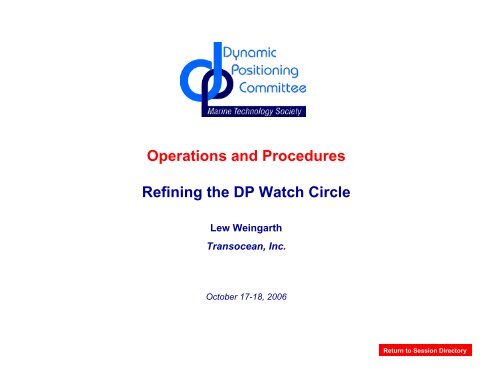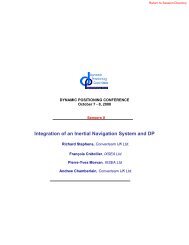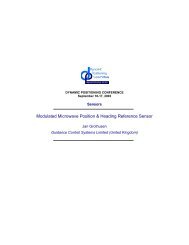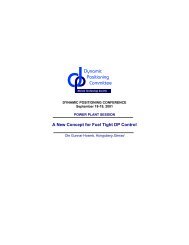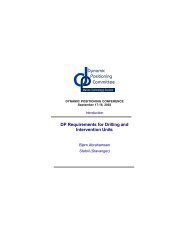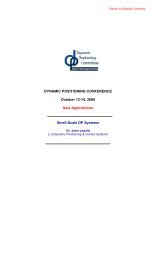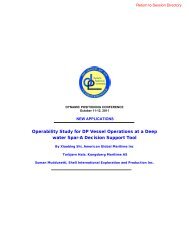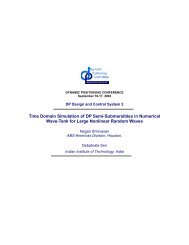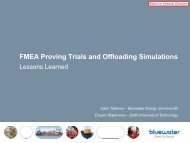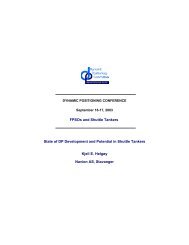Operations and Procedures Refining the DP Watch Circle - Dynamic ...
Operations and Procedures Refining the DP Watch Circle - Dynamic ...
Operations and Procedures Refining the DP Watch Circle - Dynamic ...
Create successful ePaper yourself
Turn your PDF publications into a flip-book with our unique Google optimized e-Paper software.
<strong>Operations</strong> <strong>and</strong> <strong>Procedures</strong><strong>Refining</strong> <strong>the</strong> <strong>DP</strong> <strong>Watch</strong> <strong>Circle</strong>Lew WeingarthTransocean, Inc.October 17-18, 2006Return to Session Directory
<strong>Refining</strong> <strong>the</strong> <strong>DP</strong> <strong>Watch</strong> <strong>Circle</strong>Lew Weingarth<strong>DP</strong> Superintendent,Transocean OffshoreDeepwater Drilling Inc.MTS <strong>DP</strong> Conference Houston17-18 October 20061
<strong>Refining</strong> <strong>the</strong> <strong>DP</strong> <strong>Watch</strong> <strong>Circle</strong><strong>Watch</strong> circles were used on <strong>the</strong> first <strong>DP</strong> OilDrilling Rig, <strong>the</strong> Sedco 445, in about 1970, toclearly define when to safely disconnect during aloss of location.• In 1970, riser connectors<strong>and</strong> EDS timing establishedwatch circles• <strong>DP</strong> rigs still use “watchcircles”• As rigs moved into deeperwater, more factors had to beconsidered• Even deeper water willrequire even moresophistication.2
<strong>Refining</strong> <strong>the</strong> <strong>DP</strong> <strong>Watch</strong> <strong>Circle</strong>Origin of <strong>Watch</strong> <strong>Circle</strong>sIn order to drill offshore <strong>the</strong> well boremust be extended from <strong>the</strong> sea floor to<strong>the</strong> drilling rig. The system used toaccomplish this consists of:1. Wellhead2. Blowout Preventer (BOP)3. Marine Riser4. Upper <strong>and</strong> lower flexible joints5. Telescopic or slip joint6. Riser tensioners3
<strong>Refining</strong> <strong>the</strong> <strong>DP</strong> <strong>Watch</strong> <strong>Circle</strong>Origin of <strong>Watch</strong> <strong>Circle</strong>s4
<strong>Refining</strong> <strong>the</strong> <strong>DP</strong> <strong>Watch</strong> <strong>Circle</strong>On Location 5° Riser Angle DisconnectedIn 1974, <strong>the</strong> Sedco 445 set a world record for successfully drilling in 600 meters of water.In 600 meters of water, <strong>the</strong> limiting factor for rig offset was simple, <strong>the</strong> maximum angle atwhich <strong>the</strong> rig could disconnect from <strong>the</strong> BOP.This limit was about 5° (8.7% of water depth) (Scale of ship & BOP adjusted for clarity)5
<strong>Refining</strong> <strong>the</strong> <strong>DP</strong> <strong>Watch</strong> <strong>Circle</strong><strong>Watch</strong> circles in 1970 allowed areasonable of rig motion while stillkeeping risk to a minimum(Typical of 1970, 600 meters of water – drawn to scale)6
<strong>Refining</strong> <strong>the</strong> <strong>DP</strong> <strong>Watch</strong> <strong>Circle</strong>1970 to 1995• Water depth records increased from 600 meters in 1974 to 2,000meters by 1983• YELLOW <strong>and</strong> RED were larger than <strong>the</strong> normal operatingenvelope, yet well inside <strong>the</strong> POD.• Simple watch circles provided adequate time to disconnect withoutunnecessarily restricting drilling operations.• From 1983 to 1995 <strong>the</strong> water depth record increased 300 meters• <strong>Watch</strong> circles in 1995 similar to 1970.• Beyond 2,000 meters o<strong>the</strong>r limits became important– Riser tensioner pulldown– slip joint extension– Moon pool contact7
<strong>Refining</strong> <strong>the</strong> <strong>DP</strong> <strong>Watch</strong> <strong>Circle</strong>8
<strong>Refining</strong> <strong>the</strong> <strong>DP</strong> <strong>Watch</strong> <strong>Circle</strong>1995 to 2006• By 1995 <strong>the</strong> offshore drilling industry was recovering– Seismic technology greatly increased find ratio in deep water– World economic recovery– Tax Incentives to drill offshore• Many attractive targets beyond 2,300 meters required– Longer, stronger, heavier riser– Taller <strong>and</strong> heavier BOPs, more functions, slower EDS– Taller drill floors– New drilling technologies– More crew <strong>and</strong> specialists• Drilling in deeper water required larger rigs9
<strong>Refining</strong> <strong>the</strong> <strong>DP</strong> <strong>Watch</strong> <strong>Circle</strong>1995 to 2006• Larger rigs changed <strong>the</strong> risk formula.• <strong>Watch</strong> circles of 1970 were inadequate.• Factors to be considered included:– Riser connector– Riser tensioner / slip joint stroke range– Multiple EDS sequences–Flex Joint stiffness– Upper flex joint angle– Well head / casing / soil strength–Rig velocity– Drift off analysis– Special operations or equipment• Sophisticated tools required for complex analysis10
<strong>Refining</strong> <strong>the</strong> <strong>DP</strong> <strong>Watch</strong> <strong>Circle</strong>Outputs simple watch circlesSophisticated AnalysisSimilar to 197011
<strong>Refining</strong> <strong>the</strong> <strong>DP</strong> <strong>Watch</strong> <strong>Circle</strong>Well Specific Operating GuidelinesDefine <strong>the</strong> response for anysituation.• Critical equipment faults orfailures• Operating near capability• Special operations• Normal operations infrequentlyperformed• Vessel motion• Sea floor obstructions• Hurricanes• Loop current• SIMOPS• CLOSEOPS12
<strong>Refining</strong> <strong>the</strong> <strong>DP</strong> <strong>Watch</strong> <strong>Circle</strong>Deepwater rigin 600 metersof waterSedco 445 in600 metersof waterDeepwater rigin 1,400meters ofwaterDeepwater rigin 3,000meters ofwater13
<strong>Refining</strong> <strong>the</strong> <strong>DP</strong> <strong>Watch</strong> <strong>Circle</strong>The Future• New rigs will likely be more complex <strong>and</strong> larger• SIMOPS will become more common• CLOSEOPS will become more common• Drilling innovations will require that we movecloser to <strong>the</strong> operating envelope• The challenge for <strong>the</strong> <strong>DP</strong> industry is to makesure we can support <strong>the</strong> advance of drillingtechnology while maintaining acceptable watchcircles.• Following are some ideas how we may progress14
<strong>Refining</strong> <strong>the</strong> <strong>DP</strong> <strong>Watch</strong> <strong>Circle</strong>The Future• Faster emergency disconnect• BOP stack angle• Riser tension management• Riser angle management• Velocity measurement• Velocity management• <strong>Dynamic</strong> watch circle• Whatever we do, keep it simple15
<strong>Refining</strong> <strong>the</strong> <strong>DP</strong> <strong>Watch</strong> <strong>Circle</strong>ConclusionThe watch circle is a powerful, yet simpletool to manage risk.Over <strong>the</strong> past 3+ decades, we have been ableto retain this tool, though <strong>the</strong> analysis toderive <strong>the</strong> watch circles has changedsignificantly.It seems likely that we can continue to defineour limits as watch circles as we move intodeeper water in our search for more oil.16
<strong>Refining</strong> <strong>the</strong> <strong>DP</strong> <strong>Watch</strong> <strong>Circle</strong>Thank youLew Weingarth<strong>DP</strong> Superintendent,Transocean OffshoreDeepwater Drilling Inc.lweingarth@houston.deepwater.comMTS <strong>DP</strong> Conference Houston17-18 October 200617


